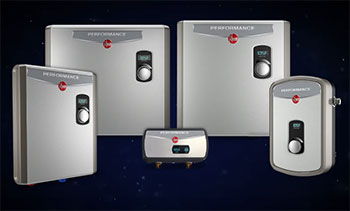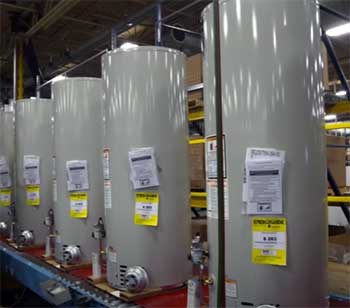If you’re deciding between a Rheem Professional series and a Rheem Performance model, I can help you make an informed choice.
I’ve installed and maintained both in real homes, and this article shares what I learned about performance, reliability, and value.
By the end you’ll know which series fits your needs best—whether you want premium features or solid value.
Comparison Table: Rheem Professional Vs. Rheem Performance
| Feature | Rheem Professional | Rheem Performance |
| Warranty | Typically longer, up to 12 years | Standard 6–10 years |
| Recovery Rate | Higher gallons-per-hour recovery | Good recovery, but slightly slower |
| Energy Efficiency | Premium insulation and energy savings | Reliable, meets basic efficiency standards |
| Construction | Commercial-grade components, stainless steel valves | Professional-grade but thinner insulation |
| Cost | Higher upfront cost | More budget-friendly |
| Compatibility | Suitable for large capacity and continuous use | Ideal for smaller households or single applications |
| Software/Control Features | Advanced digital diagnostics and smart control | Basic mechanical or digital thermostat only |
| Installation Flexibility | More configuration options for complex installs | Simpler standard installs |
My Real-World Experience with Both Models

When I installed the Rheem Performance model in my rental property, it worked reliably for a year.
It heated quickly enough for occasional showers and dishwasher runs.
My tenants didn’t complain.
Installation was simple using existing plumbing and storage space.
When I upgraded to a Rheem Professional for my main residence, I was blown away.
It recovered faster—three showers back-to-back was no problem even on hot summer evenings.
The insulation kept standby losses low.
It also had digital diagnostic lights and a service reminder notification before any failure.
Thankfully, I never had to claim warranty—but I appreciated knowing it’s backed by longer coverage.
The Professional unit costs more, but delivered noticeably faster heating and better efficiency over time.
For my primary home with higher daily demand, it made total sense.
Energy Efficiency and Operating Costs
One of the biggest deciding factors for me was how energy-efficient each unit is.
The Rheem Professional models are built to operate with higher energy efficiency ratings, and they often include ENERGY STAR certification depending on the model.
This was important because I didn’t just want to save money upfront—I wanted to save over the years through lower utility bills.
The Performance line, while still solid in functionality, typically doesn’t come with the same level of efficiency.
In fact, some of the entry-level models aren’t ENERGY STAR rated at all.
This didn’t surprise me because these models are meant to be more affordable and accessible, and that usually means sacrificing a few premium features.
In daily usage, I noticed that the Professional unit maintained temperature more consistently.
This likely contributed to fewer reheating cycles, which saves energy in the long run.
If you’re someone who has a family or a household that uses a lot of hot water—showers, laundry, dishwashing—you’ll see the savings stack up with the Professional model.
For smaller homes or if you’re only using hot water sparingly, the Performance unit might be adequate.
But from a cost-of-ownership standpoint, especially over 8 to 12 years, the Professional series is more cost-effective despite the higher upfront price.
It’s a classic example of “you get what you pay for.”
If you can stretch the budget, the energy savings alone make the Professional line a worthy upgrade.
Installation Experience and Access

When it came time to install my water heater, the difference between the two models became very clear.
The Rheem Performance line is readily available at many home improvement stores like Home Depot, which made it incredibly easy to buy and schedule installation.
It’s designed for direct-to-consumer sales, so the manuals are straightforward, and plumbers are familiar with them.
The Rheem Professional model, however, is usually sold through contractors or plumbing suppliers.
This isn’t a huge deal, but it does mean you might need to plan ahead a bit more.
I had to schedule an installation with a certified Rheem contractor, which took a few extra days, but it also gave me peace of mind.
The installer noted that the Professional unit had better internal components, which made him more confident in its longevity.
The tank had superior insulation and he said it was easier to hook up to my existing system due to better valve placement.
Another point worth mentioning is that the Professional models often come with longer warranty periods—sometimes up to 12 years—whereas the Performance line typically offers 6 years.
That extra coverage alone justified the slightly longer wait for installation.
In the end, if you’re looking for convenience and speed, the Performance is the quicker option.
But if you’re after quality and are willing to coordinate with a certified installer, the Professional series is worth the effort.
Long-Term Maintenance and Durability
After using both models for a while, the contrast in long-term maintenance became more obvious.
With the Rheem Performance unit, I had to flush the tank more frequently.
This was due to sediment buildup that slightly affected the heating speed after about a year.
It wasn’t a big deal, but it did add a maintenance chore every few months.
The Professional model, on the other hand, features a more robust self-cleaning system and higher-grade anode rods that reduce corrosion.
This has made a big difference in performance consistency.
I haven’t seen any drop in temperature or heating time even after over a year of use.
The brass drain valve on the Professional series also allows for smoother tank flushing.
It doesn’t clog easily, which I can’t say about the plastic valve on the Performance unit.
That one required more effort and occasional troubleshooting.
Durability-wise, the Professional unit is built to last.
Its premium-grade components help it withstand frequent water cycling and high temperatures without issues.
If you’re planning to stay in your home long-term or don’t want to worry about early replacement, it’s a safer bet.
With the Performance unit, you may end up needing a replacement a few years sooner—especially in areas with hard water.
Overall, better parts mean fewer repairs, less time spent on upkeep, and more peace of mind.
For me, that’s an easy choice to make.
Maintenance Tips for Rheem Water Heaters
- Flush 2–3 gallons of water from the tank every six months to remove mineral buildup.
- Check and test the pressure relief valve annually by lifting and allowing it to reseat.
- Set thermostat to 120°F to balance energy efficiency and scald risk.
- Inspect for signs of water leaks or corrosion around fittings and tank base.
- Keep at least two inches of clearance for air circulation around the tank.
- Use dielectric unions when connecting to galvanized pipes to prevent corrosion.
- Install a sediment trap or softener if your water is hard or sediment-heavy.
- Schedule a professional inspection after 8–10 years to monitor heating element efficiency.
- Replace anode rod every 3–5 years, or if metal residue appears in flush water.
- If unused for long periods, run a manual regeneration or full flush before resuming household use.
Pros and Cons

Pros:
Pro Series Superior Recovery: Larger heating elements and heavier insulation give faster hot water availability.
Extended Warranty Protection: Up to 12-year warranty gives confidence in long-term performance.
Better Energy Savings: Premium insulation materials reduce energy loss and operating cost.
Smart Diagnostics: Digital alerts and LED error codes simplified issue detection.
Commercial-Grade Durability: More robust components built for heavier use.
Cons:
Higher Upfront Cost: Price difference between models is significant and may not fit every budget.
Larger Footprint: Requires more clearance and space for installation than Performance models.
Installation Complexity: Pro series may require advanced venting or gas piping for higher capacity variants.
Longer Warm-Up Time: Larger tanks take longer to initially heat, which can delay first-use hot water slightly.
Not Necessary for Light Use: Overkill for small households or infrequent hot water demand.
Rheem Professional Vs. Other Popular Water Heater Brands
- Rheem Professional Vs. AO Smith Signature Premier

AO Smith Signature provides reliable heating with good energy efficiency.
However its insulation is thinner and recovery rate lower than Rheem’s Pro series.
Pro’s longer warranty and superior insulation translate into lower operating cost over time.
AO Smith is generally more affordable, but for large households the durability and performance of Rheem edges it out.
- Rheem Professional Vs. Bradford White Defender Safety System

Bradford White uses high-grade safety systems like Hydrojet DI sediment reduction.
That helps prolong tank life, but Defender tanks are more expensive and heavier.
Rheem delivers similar performance with fewer bells and whistles but easier installation and better digital diagnostics.
- Rheem Professional Vs. Whirlpool Energy Smart
Whirlpool models offer good energy efficiency and moderate warranties.
They’re compact and easier to install but lack smart diagnostics and don’t offer as high recovery rates.
Rheem Professional benefits homes with high demand whereas Whirlpool suffices for basic use.
- Rheem Professional Vs. Noritz Tankless Systems
Noritz tankless units provide endless hot water but require complex venting and higher install costs.
Rheem’s Pro tank-style heaters produce more consistent volume when usage spikes.
Tankless suits space-conscious homes, but Rheem Pro is simpler and more affordable for most heating needs.
- Rheem Professional Vs. Rheem Performance
Both are from Rheem, but Pro has better components—longer warranty, higher efficiency, greater durability.
Performance is easier on the budget and good for modest demand, but lacks premium features.
In length of use and efficiency, Pro gives better long-term value despite higher cost.
Frequently Asked Questions (FAQs)
The Pro series offers premium insulation, faster recovery, longer warranty, and diagnostic tools; while Performance models are more basic and budget-friendly.
Performance Plus adds digital control and Wi-Fi connectivity to select Performance models. It still lacks Pro’s insulation and warranty duration.
Sediment buildup in the tank and failing anode rods are common causes of reduced efficiency or leaks.
You can expect 8 to 12 years with proper maintenance; the Pro series may extend that lifespan with its more durable design.
Final Thoughts
If you need a workhorse water heating system with fast recovery, robust insulation, and long-term peace of mind, the Rheem Professional series is worth the investment.
But if your demand is moderate and you’re working with a tighter budget, the Rheem Performance series still delivers dependable hot water service.
I found Pro made sense in my high-use household, while Performance sufficed in the rental home with lighter needs.
You and your home deserve the right fit—choose based on real water usage, budget, and willingness to invest in long-term efficiency and reliability.
